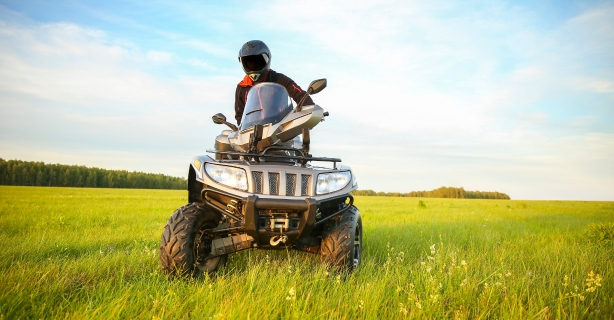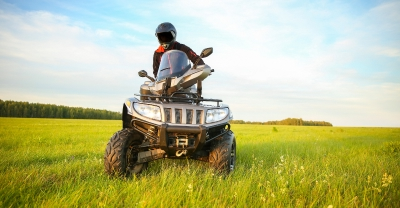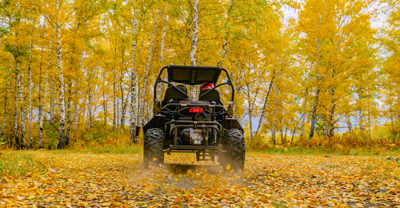Beginner’s guide to off-road riding


0 min. read
Off-road riding is an exciting way to explore the outdoors—especially if you’ve just gotten your first ATV or UTV. That first outing can bring a mix of adrenaline and anticipation. But before you start, it helps to know what to expect. These machines are built for rough terrain—but that doesn’t mean every ride is easy. Loose gravel, tight turns, low visibility, and shared trails can all add to the challenge—especially when you’re just starting out.
This guide introduces beginner-friendly essentials like safety, gear, riding techniques, and trail etiquette.

Prioritize off-road safety from the start
Getting your first off-road vehicle is a big milestone—congratulations! But before you head out, take a few minutes to think through safety basics.
Focusing on safe habits early helps set the tone for every experience that follows. Build your confidence at your own pace, ride with others when you can, and learn by doing—because every trip is a chance to sharpen your skills.
Helpful starting points:
Begin in a flat, open space to get a feel for steering, braking, and handling.
Choose beginner-friendly trails with fewer obstacles and gentle inclines. Wait to ride steep hills, deep mud, or rocky paths until you're more experienced.
Inspect your vehicle before each ride. Check tires, brakes, and any lights or signals your new machine uses.
Get a feel for body positioning
Off-road riding takes more than just steering—you’ll use your whole body to stay balanced and in control. Whether you're climbing a hill or turning on a trail, shifting your weight can help your vehicle respond more smoothly to the terrain.
At first, these movements might feel awkward. But with practice, they’ll start to feel more natural.
Tips to help you stay balanced and ride with more control:
Stay relaxed: Keep your elbows and knees slightly bent. Stiff arms and legs can throw off your balance and make it harder to respond to the trail.
Shift your weight on hills: Lean forward when climbing and lean back when going downhill. This helps keep your tires planted and improves traction.
Lean into turns: If you're turning left, gently lean your body left—same goes for right turns. This helps your machine stay stable and lowers the chance of tipping.
Use your legs to absorb bumps: When riding over rocks or rough spots, stand slightly on your footrests. Let your legs absorb the impact—it’s easier on your body and can help smooth out the ride.
As you practice, focus on staying loose and responsive. Over time, reading the terrain and adjusting your body position can become second nature.
Choose off-road gear that helps you stay protected
Off-road riding can take you places roads can’t—from muddy trails and loose gravel to rocky hills and hidden tree roots. That kind of unpredictable terrain can challenge even experienced riders, so wearing protective gear is a key part of getting started with confidence.
Start with these essentials:
Helmet: A DOT-approved off-road helmet helps protect your head from impact and is designed with room for goggles. It’s one of the most important pieces of gear to use.
Goggles: Flying dirt, grit, and bugs can quickly ruin a ride. Goggles can help keep your vision clear and your eyes protected.
Gloves: Off-road gloves help improve grip, help prevent blisters, and offer protection from brush and branches. Some gloves have extra padding that can help with hand fatigue.
Boots: Look for over-the-ankle boots built for rough terrain. They help support your feet and ankles and can give you better stability on uneven ground.
Long sleeves and pants: Durable fabric creates a barrier between you and whatever the trail throws your way—scratches, sunburn, or stinging weeds.
You don’t need to outfit yourself like a pro on your first ride. Start with the basics and build from there. The goal is to feel prepared, protected, and ready to enjoy the ride.

Ride with respect for the trail and others
Being a responsible rider starts with how you show up on the trail. Respect goes a long way toward other riders, hikers, landowners, and the environment.
Off-road etiquette 101:
Yield to others: Give the right of way to hikers, runners, and other vehicles when you meet on shared trails.
Stick to the route: Avoid cutting corners or blazing your own path—marked trails are there to protect both riders and the environment.
Signal clearly: Use hand signals to let your group or other riders know when you're turning, stopping, or passing.
Adjust your speed: Slow down in poor weather, on blind corners, or when visibility drops.
Leave no trace: Pack out what you pack in, including snacks, tools, and any gear you bring.
Keep your ride in good shape
Off-roading can push your vehicle in ways regular roads don’t. From deep ruts to rocky climbs, the wear adds up—especially as you get used to how your machine handles different terrain. That’s why it helps to start a simple maintenance routine early. A few regular checks can go a long way toward keeping your ride dependable.
Start by getting to know your vehicle—your owner’s manual can show you where to look and what to check. You can also connect with other riders or a trusted mechanic to learn firsthand. Over time, those small steps build confidence—and help you catch problems before they leave you stuck.
Helpful habits to start with:
Check your tires regularly for wear, low pressure, or punctures
Top off essential fluids like oil, coolant, and transmission fluid as needed
Schedule a service check once a year—or sooner if something feels off
Rinse off mud and debris after every ride to help prevent long-term wear
Consider off-road insurance as part of your prep
Theft or trail damage can happen—even when your vehicle’s parked or you’re taking all the right precautions. Off-road insurance can help you manage the costs that come with unexpected repairs or losses, depending on the coverages you choose.
Dairyland®, a brand of the Sentry Insurance Group, offers flexible insurance options for ATVs, UTVs, and other off-road vehicles. When you're ready, we’re here to help you explore what types of protection might make sense for your ride.

The general information in this blog is for informational or entertainment purposes only. View our blog disclaimer.










